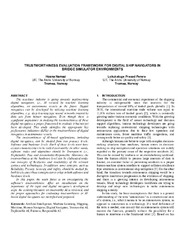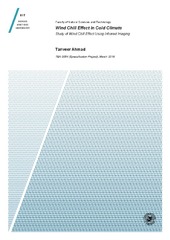Browsing Artikler, rapporter og annet (teknologi og sikkerhet) by Title
Now showing items 290-309 of 309
-
Temperature-driven variation in the removal of heavy metals from contaminated tailings leaching in northern Norway
(Journal article; Tidsskriftartikkel; Peer reviewed, 2019-01-31)High amounts of tailings with a low recycling rate are generated during mining and smelting processes, and a lot of environmental problems were caused by heavy metal leaching from tailings. Temperature is a key point in heavy metals leaching, and knowing the effects of temperature on tailings leaching is useful for tailings management. A small-scale batch leaching experiment was conducted at different ... -
Thermal Properties of SK One Component Polyurethane using Experiments and Multiphysics Simulations
(Conference object; Konferansebidrag, 2016-12-08)This study proposes to determine the thermal conductivity of SK One Component Polyurethane (SKOCP) developed by China Institute of Water Resources & Hydropower Research Beijing IWHR-KHL Co. Ltd. SKOCP provides excellent proof of aging and chemical resistance of this material. It is non-toxic, acts as a good anti-seepage, offers anti-abrasion and good anti-freezing performance. In addition, it has ... -
Time to Rescue for Different Paths to Survival Following a Marine Incident
(Journal article; Tidsskriftartikkel; Peer reviewed, 2020-12-07)The time required for rescue is a critical factor for surviving a marine incident. The regulatory framework, International Maritime Organization (IMO) Polar Code, utilizes a risk-based approach. It states that the vessel operators are to define the time required for rescue but never less than 5 days. Based on experience from the classification society DNV GL, utilization of the minimum requirement ... -
Trend effects on perceived avalanche hazard
(Journal article; Tidsskriftartikkel; Peer reviewed, 2022-08-30)Hazard-level forecasts constitute an important risk mitigation tool to reduce loss of economic values and human life. Avalanche forecasts represent an example of this. As for many other domains, avalanche risk is communicated using a color-coded, categorical risk scale aimed at informing the public about past, current, and future risk. We report the results from three experiments in which we ... -
Trends in seismic data acquisition in areas with surface ice
(Peer reviewed; Bok; Chapter, 2019)The Arctic has great significance in relation to the exploration and exploitation of its huge petroleum resources. Seismic surveys are the key part of petroleum exploration. Reflected sound waves are used to produce a 3D subsurface geological model, which helps to take a decision on drilling location for potential hydrocarbon resources. Seismic surveys are very complex operations, and growing energy ... -
Trustworthiness Evaluation Framework for Digital Ship Navigators in Bridge Simulator Environments
(Chapter; Bokkapittel, 2023)The maritime industry is going towards implementing digital navigators, i.e., AI created by machine learning algorithms, on autonomous vessels in the future. Digital navigators can be developed by utilizing machine learning algorithms, e.g., deep learning type neural networks trained by data sets from human navigators. Even though there is significant importance in studying the trustworthiness of ... -
Typical hydrodynamic models for aquaculture nets: A comparative study under pure current conditions
(Journal article; Tidsskriftartikkel; Peer reviewed, 2020-03-17)The net is regarded as the most critical component in marine aquaculture facilities as it is the only barrier which protects the environment from fish escapes. Accurate predictions of the net cage deformation and drag force on the nets are needed, both for ensuring fish welfare and for dimensioning of the mooring system. Thus, an appropriate hydrodynamic model is essential. In practice, two types ... -
Uncertainties in Managing Atmospheric Icing on Power Lines
(Chapter; Bokkapittel, 2023)Icing affects the infrastructure dramatically, especially in the cold region. Therefore, applying effective ice disaster management (IDM) to provide a systematic approach to dealing with atmospheric icing on power lines is essential. It includes preparedness, response, recovery, learning, risk assessment, and prevention. Integral to this management is the accurate prediction and modeling of icing, ... -
Unprecedented Vessel-Icing Climatology based on Spray-Icing Modelling and Reanalysis Data: A Risk-Based Decision-Making Input for Arctic Offshore Industries
(Journal article; Peer reviewed, 2019-04-11)Marine icing is considered a major concern for vessels operating in the Arctic Ocean. Interaction between vessels and waves is the major source of sea spray that, under certain conditions, can lead to ice accretion on the vessels and thus create hazardous situations. Various models have been developed for the estimation of ice accretion rate using meteorological and oceanographic parameters. Various ... -
Use of simulator training to mitigate risks in arctic shipping operations
(Journal article; Tidsskriftartikkel; Peer reviewed, 2019-06)Over the recent years, ship traffic in the polar areas has increased. There is reason to believe that this traffic, and especially the cruise traffic, will increase further as the ice retracts towards the poles. There is also reason to believe that with the continued focus and exposure of the Polar Region, the cruise tourism to the region will grow. The increased presence in the polar areas will ... -
User Engagement in Developing Use-Inspired Glacial Lake Outburst Flood Decision Support Tools in Juneau and the Kenai Peninsula, Alaska
(Journal article; Tidsskriftartikkel; Peer reviewed, 2021-04-15)Glacial lake outburst floods (GLOFs) significantly affect downstream communities in Alaska. Notably, GLOFs originating from Suicide Basin, adjacent to Mendenhall Glacier, have impacted populated areas in Juneau, Alaska since 2011. On the Kenai Peninsula, records of GLOFs from Snow Glacier date as far back as 1949, affecting downstream communities and infrastructure along the Kenai and Snow river ... -
User Satisfaction in Augmented Reality-Based Training Using Microsoft HoloLens
(Journal article; Peer reviewed, 2019-01-25)<p>With the recent developments in augmented reality (AR) technologies comes an increased interest in the use of smart glasses for hands-on training. Whether this interest is turned into market success depends at the least on whether the interaction with smart AR glasses satisfies users, an aspect of AR use that so far has received little attention. <p>With this contribution, we seek to change ... -
Vanadium removal from mining ditch water using commercial iron products and ferric groundwater treatment residual-based materials
(Journal article; Tidsskriftartikkel; Peer reviewed, 2022-08-06)Removal of vanadium from liquid waste streams protects the environment from toxic vanadium species and promotes the recovery of the valuable metal. In this study, real mining ditch water was sampled from a closed vanadium mine (V–Fe–Ti oxide deposit, Finland) and used in sorption experiments at prevailing vanadium concentration (4.66–6.85 mg/L) and pH conditions (7.02–7.83). The high concentration ... -
Verneombudets rolle i sikkerhetsarbeidet - case-studier i bygg og anlegg
(Research report; Forskningsrapport, 2020-08-21)Rapporten beskriver resultatene fra en kartlegging der formålet har vært å få økt kunnskap om verneombudets rolle, utfordringer og muligheter knyttet til deres deltakelse i sikkerhetsarbeidet i bygg- og anleggsprosjekter.<br><br> Datainnsamlingen har vært to-delt: Intervjuer med ulike aktører i tre case-prosjekter, og intervju/samtaler med RVO Bygg og RVO Anlegg. Det er identifisert åtte ... -
Vertical profiles of black carbon and nanoparticles pollutants measured by a tethered balloon in Longyearbyen (Svalbard islands)
(Journal article; Tidsskriftartikkel; Peer reviewed, 2022-09-09)Airborne meteorological and aerosol measurements have been performed in Longyearbyen (Svalbard islands) in the summer of 2018, coupling an instrumental aerosol payload with a meteorological radiosonde deployed on a tethered balloon. More than 70 vertical profiles of aerosol and meteorological properties have been recorded up to a maximum altitude of 1.2 km. As a main result, the present work provides ... -
Way-finding on-board training for maritime vessels
(Journal article; Peer reviewed, 2018-01-03)In the maritime industry, it is of vital importance that personnel onboard ships are familiarized with the ship’s layout, along with safety equipment and processes for safeguarding of the individual seafarer and the ship’s crew. In fact, international maritime regulations require that all personnel employed or engaged on a seagoing ship receive proper familiarization training. However, several studies ... -
What makes an acute emergency? Temporal manifestation patterns and global health emergencies
(Journal article; Tidsskriftartikkel; Peer reviewed, 2023-06-09)In this article, we consider the role that onset patterns play in shaping how acute global events are taken to be, drawing on illustrative cases from the field of global health emergencies. We identify four temporal manifestation patterns that we argue display distinct political dynamics. First, an emergent onset pattern (e.g. the H1N1 health emergency), with political dynamics dominated by ... -
What similarities can municipalities experience in crisis management?
(Conference object; Konferansebidrag, 2017-06)Municipalities have an important role in crisis management. The Norwegian emergency principles of responsibility, parity and proximity are central, and the government expects municipalities to take care of crises in their area in accordance with the civil protection law. Due to the varying natures of different crises, one can expect crisis management to take different paths. This paper challenges ... -
Why Is the Construction Industry Killing More Workers Than the Offshore Petroleum Industry in Occupational Accidents?
(Journal article; Tidsskriftartikkel; Peer reviewed, 2021-07-07)In Norway, the fatal accident frequency per year is discernibly higher in the construction industry than in the petroleum industry. To probe the difference between the occupational safety levels in the two industries in Norway, semi-structured interviews with regulators, employer and employee organisations, company management, and safety personnel were conducted. This qualitative approach, together ... -
Wind Chill Effect in Cold Climate: Study of Wind Chill Effect Using Infrared Imaging
(Research report; Forskningsrapport, 2016)Wind chill factor is explained as the cooling sensation due to the exposure of wind temperature environment. The wind chill factor depends on air temperature, wind velocity and humidity. Wind chill poses serious health risks. Various wind chill index models are given in literature. In order to understand the wind chill effect, it is important to understand the phenomenon of heat transfer. There are ...


 English
English norsk
norsk


















